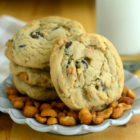
Rolling pins are an essential piece of kitchen equipment for a variety of different cooking tasks. You need them to roll out pie dough, puff pastry and cookie dough for cut-out cookies. They can also be used for other kitchen tasks, like crushing nuts, pepper and ice, or tenderizing meat. You may not need it every day, but the “kitchen hacks” that suggest using a wine bottle or other object just don’t get the job done as easily and efficiently as a real rolling pin.
But there is more than one type of rolling pin out there – so how do you pick one out? There are two main properties of a rolling pin that you need to take into consideration – the shape and the material it is made out of – but you will also need to consider what you’ll be using the rolling pin for when picking one out.
Rolling Pin Shape
There are three main types of rolling pins: tapered rolling pins, straight (cylindrical) rolling pins and rolling pins with handles. Tapered rolling pins are generally considered to be the best choice for rolling out pastry and yeasted doughs. The ends of a tapered pin are easy to grip and make it easy to move the dough around your work space, stretching it as you go. You can get a little more aggressive with a dough that might be trying to spring back into place – as many yeasted doughs can do – if you need to be. You don’t want a tapered rolling pin that has an extreme size difference between the center and the edges, a slight taper is just fine.
Straight rolling pins allow you to apply a very even pressure on whatever you’re rolling out. They’re a great choice for cookie dough or other items that you need to be a very even thickness, especially if the final size or shape of the item you are rolling out isn’t that important (cookie dough doesn’t need to be a perfect circle before you put your cookie cutters to it!).
Rolling pins with handles tend to be straight rolling pins with pin in the center that holds the handles in place. They are easy to grip, but can be more difficult to apply pressure with when it comes to rolling out a thick dough. I personally prefer a rolling pin without handles, but they’re hard to beat when it comes to grip comfort and they will similarly to a straight rolling pin without handles.

Rolling Pin Materials
The majority of rolling pins are wood, but these days it is possible to find them made of metal, marble and silicone, as well. Wood pins are the most traditional and you can’t go wrong with a wooden rolling pin. Wooden rolling pins are neither hot nor cold, and they should hold onto a dusting of flour that will prevent whatever you’re rolling from sticking.
The idea behind the metal and marble pins is that they are colder (and can even be chilled), so butter is less likely to melt as you are rolling your dough. This is a good idea in theory, but the reality is that the air temperature and the length of time you are working with your dough is going to have the biggest impact on how firm the dough remains when you are working with it. These types of pins also tend to be quite heavy, which may be a negative for some bakers.
Silicone pins, like silicone pans, have nonstick qualities and you may not need to add as much flour or sugar to your dough as you roll it out. That being said, a wood rolling pin should hold onto a little bit of flour, so it may not take as much flour as you think to roll the dough where you want it.
Choosing a Rolling Pin
So what kind of rolling pin should you choose? I would recommend getting both a straight wooden rolling pin and a tapered wooden rolling pin, so you have a solid option both for cookie dough and yeasted dough. Two rolling pins don’t take much more room than one and you’ll be covered for just about any baking project.
I’m not going to recommend a specific brand because there are many out there that are excellent pins and I feel that there is an element of personal preference to choosing one. Pick a rolling pin that is solid, but not extremely heavy. Pick a rolling pin that is reasonably long, but not so long that you have difficulty maneuvering it on the counter (I had an 18-inch rolling pin that was just too unweildy for me). Make sure the tapered pin is comfortable to hold onto at the ends or, if choosing a straight pin with handles, make sure the handles are comfortable to grip.






What do you think?